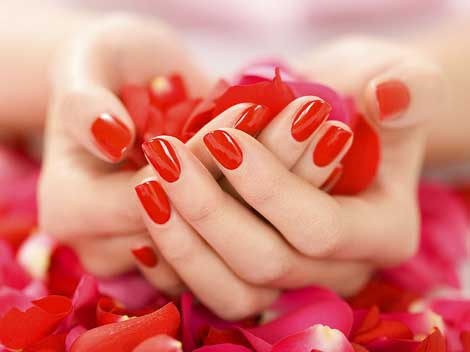 The art of fingernail painting is a tradition spanning from ancient time to the present: women in ancient China favored red colored fingernails and today painted fingernails are a fashionable trend for women.
The art of fingernail painting is a tradition spanning from ancient time to the present: women in ancient China favored red colored fingernails and today painted fingernails are a fashionable trend for women.
The beauty of women's fingers possesses a special charm. In ancient China, clothes covered almost the whole body of a person, except for the face and hands. Perhaps this is why so many renowned works usually focused on the fingers when describing the beauty of women in traditional historic literature. Women's fingers, as described by scholars in history, were delicate, soft and purely white.
As we all know, decorations of the human body are put on the most noticeable places, like the face and hands, for social and psychological reasons. It is quite natural that people, especially women, are not hesitant in spending much time and effort adorning their fingernails. Bright red and smoothly tender was suitable to describe the beauty of fingernails in the past. The famous poet Zhang You once said in his poem Play Zheng: "Ten slender fingers are like bamboo shoots of jade with pure red on top of each." Another poet, Yang Lianfu, was an expert on describing the beauty of fingernails; he gives another vivid description of fingernails: "When the balsams were in blossom, the color red becomes brighter. A beautiful woman painted her fingernails red with the balsams. When she was deep in thought with both hands supporting her cheeks, these beautiful fingernails are just like drops of rouge on the face." What a lovely picture!
Since cosmetic companies such as Revlon and Mabelline had not yet been founded, you may ask, "How did women paint their nails?" Two necessary conditions were that the color should be bright, lustrous and pleasing and the color should not fade for a long period. Women of that time always used flowers to paint their fingernails, with balsam the most commonly used.
Balsam was also named "Golden Phoenix," for the shape of its flower is like a phoenix. It originated in China, thus ancient Chinese people knew of it very early. The period of its blossom is from early summer to late autumn. There are many colored balsams, including red, purple, yellow and white. However, the red balsam was considered the most useful for painting fingernails.
The process of painting fingernails, which is neither difficult nor very simple, is as follows: Collect a number of balsam flowers and pound these into pieces, adding a little alum. Wash the fingernails clean and then apply the balsam to the fingernails–being careful to cover the whole part of each fingernail. Then wrap the fingernails with cloth or silk. Keep them wrapped for at least one night. After the first dyeing, perhaps the color of the fingernails is still light. Re-dye them at least 3–5 times, according to the said procedure. After this process, the color becomes red like rouge and won't fade until new fingernails grow out.
Women in the past had a special preference to painting their fingernails on July 7 of the lunar year, when balsams were in brilliant full bloom and arousing their love for beauty. They joyfully painted their clean and smooth fingernails red with the bright red balsam. This was a great pleasure for girls in ancient times.
Nowadays, girls still often adopt this traditional of painting their fingernails and even though this is time-consuming and uncomfortable for the fingernails, they really enjoy themselves doing this. Many women today, who paint different kinds of nail polish on their fingernails, have also inherited this tradition. Painting fingernails has definitely become fashionable in China, with well-trimmed and elaborately decorated fingernails still bringing out women's charm and beauty.





